The 1st AEARU Symposium on the Culture of Chinese Characters was held by Kyoto University on December 15–16, 2011. The event was held in cooperation with the Association of East Asian Research Universities (AEARU), the Japan Kanji Aptitude Testing Foundation, the Kyoto University Foundation and the Yomiuri Shimbun.
The idea for the symposium was first proposed by President Hiroshi Matsumoto of Kyoto University at an AEARU Annual General Meeting in 2009. President Matsumoto suggested that Chinese characters could serve as the foundation for a wide-ranging exploration of East Asian culture. The idea was enthusiastically supported by the AEARU members, and it was agreed that the inaugural symposium would be held at Kyoto University in tandem with the AEARU 17th Annual General Meeting and 29th Board of Directors Meeting, which were held on December 14, the day before the symposium.
The symposium utilized the topic of Chinese characters as a common theme through which to explore the various cultures and potential of East Asia from a diverse range of academic perspectives. Speakers included specialists in Chinese language studies, philosophy, astronomy, medicine, informatics and cosmology. The event attracted over 120 participants throughout the course of its two days.
The symposium began with a keynote speech by President Matsumoto, who broadly discussed the history and development of Chinese characters, focusing on their role in East Asian thought and philosophy, and their adoption and application in Japan. The second keynote speaker was Dr. Chao-Shiuan Liu, chairman of the General Association of Chinese Culture. Dr. Liu's presentation described some of the distinctive characteristics of Chinese characters, such as the fact that they are the only ideographic writing system still used in modern times, and that they have changed very little over the past 2500 years. Dr. Liu pointed out that, as a result of that characteristic, those who can read Chinese characters are able to comprehend texts which are over 2000 years old. Dr. Liu also asserted that it is important to standardize Chinese characters in order to deepen mutual understanding and provide a common foundation for the conservation and continuation of East Asian culture.
Following the keynote speeches, the symposium continued with its first session, an overview of the Culture of Chinese characters in East Asia. In this session, scholars from various parts of East Asia discussed the history and culture of Chinese characters in their respective regions. The session included speakers from Japan, China, Korea, Taiwan and Hong Kong, and touched on issues such as the use of Chinese characters in modern slang, the combination of Chinese characters with imported foreign words, and whether character standardization is necessary.
Session 2, subtitled "Chinese Characters and Modernization," examined the role played by Chinese characters in East Asia's early encounters with the West. Topics discussed included the inventive use of Chinese characters in expressing and describing concepts which did not previously exist in East Asian culture, and the role of Chinese characters in the development of the natural sciences. The third session was subtitled "Chinese Characters in the Information Age," and dealt with the use of Chinese characters with information technology devices and systems. The session covered topics such as translation technology and the possibilities presented by multilingual information media. In addition to the main sessions, the symposium also featured poster presentation sessions by researchers from China, Korea and Japan.
The event concluded with a public symposium titled "Chinese Character Education and Promoting the Culture of Chinese Characters in East Asia." The public symposium, which was attended by approximately 270 members of the general public, opened with speeches by President Matsumoto and Mr. Kohsaka Setsuzo, chairman of the Japan Kanji Aptitude Testing Foundation. In the first session, Mr. Yuji Miyamoto, chairman of the Miyamoto Institute of Asian Research and former Japanese ambassador to China, gave a keynote lecture titled "The Vital Role Played by Chinese Characters in East Asia." In his lecture, Mr. Miyamoto asserted that as East Asia becomes ever closer in terms of politics and economy, there is a need to reevaluate traditional East Asian culture and reaffirm the region's shared sense of values to secure a peaceful, secure and prosperous future. He concluded that the region's shared culture of Chinese characters had a vital role to play in such a deepening of mutual understanding. The next speaker was Prof. Hiroyuki Sasahara of Waseda University, who discussed various aspects of Chinese character usage in Japan, as well as the feelings and emotions that Japanese people have in relation to certain characters in his lecture "The Increasing Interest in Chinese Characters in Japan."
The second half of the public symposium took the form of a panel discussion session. The panel consisted of several of the symposium's presenters, including Mr. Yuji Miyamoto, Prof. Hiroyuki Sasahara, President Hiroshi Matsumoto, Prof. Yang Shen of Peking University, Prof. Byung-Joon Kim of Seoul National University, Dr. Kuan Yun Huang, of Tsing Hua University – Hsinchu and Prof. Qin Lu of the Hong Kong Polytechnic University. Under the chairpersonship of Prof. Tetsuji Atsuji of Kyoto University's Graduate School of Human and Environmental Studies, the panelists shared opinions and ideas on the present situation and future prospects of Chinese character use in their respective countries. Following the panel discussion session, the symposium was officially closed by Prof. Akihiko Akamatsu, Kyoto University's executive vice-president for student affairs.
The symposium was planned to be this first in a series of AEARU symposia on the culture of Chinese characters. Subsequent symposia will be held by other AEARU members in the future.
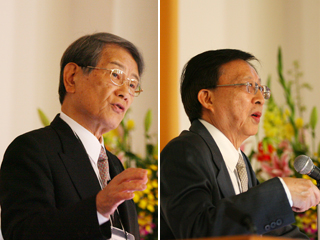 President Hiroshi Matsumoto, Dr. Chao-Shiuan Liu, chairman of the General Association of Chinese Culture | 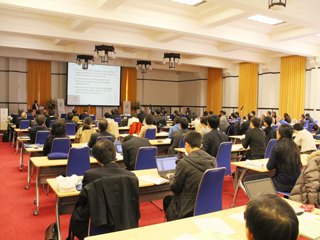 Presentation session |
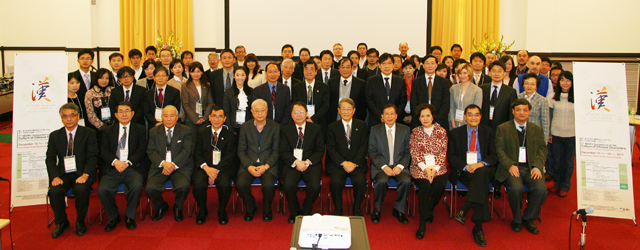 Symposium participants | |
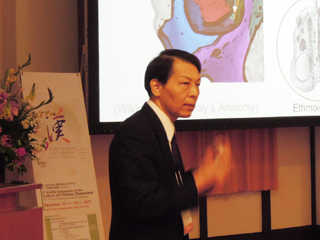 Dr. Makoto Mark Taketo, Graduate School of Medicine, Kyoto University | 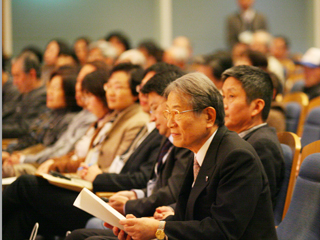 The public symposium |
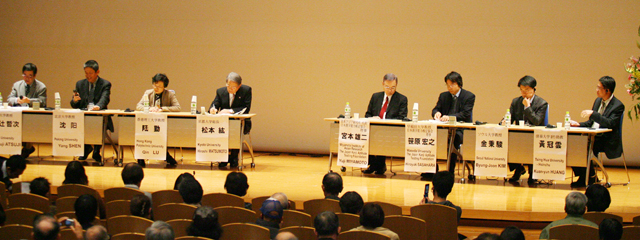 Panel discussion session | |

